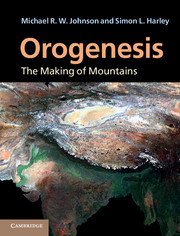Book contents
- Frontmatter
- Contents
- Preface
- Acknowledgments
- Geological timescale
- 1 Major features of the Earth and plate tectonics
- 2 Driving mechanisms for plates, slab retreat and advance, and a cause of orogenesis
- 3 Physical and chemical principles: rock deformation, isostasy, geochronology and heat production in the lithosphere
- 4 Large-scale features of orogens: thrusts and folds
- 5 Evolution of orogens
- 6 Lateral spreading of orogens: foreland propagation, channel flow and weak zones in the crust
- 7 Metamorphism in orogeny
- 8 The erosion and exhumation of mountains
- 9 Sedimentary history of the foredeep basins
- 10 Deep structure, mountain support and phase changes
- 11 Mountains and climate
- 12 Secular change in orogeny
- References
- Index
- Plate section
2 - Driving mechanisms for plates, slab retreat and advance, and a cause of orogenesis
Published online by Cambridge University Press: 05 June 2012
- Frontmatter
- Contents
- Preface
- Acknowledgments
- Geological timescale
- 1 Major features of the Earth and plate tectonics
- 2 Driving mechanisms for plates, slab retreat and advance, and a cause of orogenesis
- 3 Physical and chemical principles: rock deformation, isostasy, geochronology and heat production in the lithosphere
- 4 Large-scale features of orogens: thrusts and folds
- 5 Evolution of orogens
- 6 Lateral spreading of orogens: foreland propagation, channel flow and weak zones in the crust
- 7 Metamorphism in orogeny
- 8 The erosion and exhumation of mountains
- 9 Sedimentary history of the foredeep basins
- 10 Deep structure, mountain support and phase changes
- 11 Mountains and climate
- 12 Secular change in orogeny
- References
- Index
- Plate section
Summary
In 1928 Arthur Holmes suggested that the mechanism for continental drift is cells of convection in the mantle. This was a remarkable insight, although many would now question the one-to-one connection between plate motion and mantle convection. So what is the modern view on the driving force for plate movements? There are two models in which the plates drive themselves. The first is called ‘slab pull’, which means that the dense ocean crust exerts a pull on the ocean floor during subduction as it plunges into hot asthenosphere. In contrast, the less dense continental crust is relatively buoyant. Sometimes the subducted slab of ocean crust breaks off and sinks into the hot asthenosphere, but if it survives it will exert a traction and in effect pull the ocean crust away from the Mid Ocean Rise. The opposite view is ‘slab push’, which means that the driving force for the moving ocean floor is situated at the Mid Ocean Rise which is opening under extension to allow in the new ocean crust.
Perhaps it should not be either/or here. Phillip England (1982) calculated the required stresses at the Mid Ocean Rise in the Indian Ocean if slab push were to be responsible for the northward movement of the Indian plate carrying the Indian continent. The forces acting on a plate boundary must do work against gravity during the raising of high mountains and plateaux. The force balance must take into account the Argand number, which expresses the relative magnitudes of the buoyancy forces arising from contrasts in crustal thickness and the forces required to deform the medium. England's results show that the horizontal stress arising from slab push is enough to explain not only the motion of the Indian plate before collision but also the continuation of motion after the India–Asia collision, with the result that India indents Asia, and a wave of deformation has spread across the Asian continent for over 2000 km north of the Himalaya.
- Type
- Chapter
- Information
- OrogenesisThe Making of Mountains, pp. 10 - 15Publisher: Cambridge University PressPrint publication year: 2012

